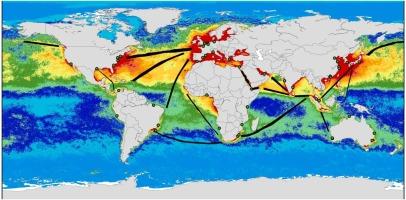COVID-19 封锁期间全球航运 NO2 污染的变化:对可持续海洋作业的影响
IF 12.2
1区 环境科学与生态学
Q1 ENGINEERING, ENVIRONMENTAL
引用次数: 0
摘要
封锁(LD)期间对人类旅行和消费的严格限制影响了全球海上交通和作业。由于人类活动受到限制,因此禁渔期是研究污染物排放的理想时期。虽然船舶会排放多种污染物,但最重要的是二氧化氮(NO2),它可被视为船舶排放的指标。因此,我们研究了 LD 期间全球航道、港口和海岸的二氧化氮污染变化。根据 TROPOMI 卫星测量数据的分析,我们发现在低纬度地区的主要航线上,包括经由北大西洋的美欧贸易航线、经由阿拉伯海的亚洲-中东航线、洲际航线以及经由北海和波罗的海的欧洲内部航线上,二氧化氮的排放量大幅下降了约 10-20%。据估计,好望角和马六甲海峡等海上直航通道的气流也会出现类似的减少。此外,卡亚俄、桑托斯、安特卫普、鹿特丹、釜山、图巴劳、理查兹湾、巴塞罗那、德班和钦奈等全球主要港口的 NO2 在低纬度地区显著下降,降幅约为 30%。航运路线和港口的二氧化氮下降可归因于低排放限制导致货船、客船、渔船和油轮密度下降;这与排放清单分析一致。因此,本研究建议航运业采取严格的环境政策来抑制排放,因为污染是港口城市和沿海地区公众健康的一大隐患。 环境影响 COVID-19 封锁(LD)期间对人类流动的严格限制和消费的限制对全球的船舶运营产生了重大影响。与其他有害空气污染物和温室气体的来源一样,航运也对空气质量差的总体负担产生了显著影响。然而,我们发现,在禁航期内,全球主要港口、海岸和航道的二氧化氮(NO2)污染大幅下降,但在禁航期后却急剧逆转。因此,本研究将低密度地区作为一个自然实验,以制定可持续航运运营战略,遏制有害空气污染。本文章由计算机程序翻译,如有差异,请以英文原文为准。

Changes in global NO2 pollution by shipping during the COVID-19 lockdown: Implication for sustainable marine operations
Severe restrictions on human travel and consumption during the lockdown (LD) have affected global marine traffic and operations. The LD period is ideal for studying the emissions as there were restricted human activities. Although several pollutants are emitted by ships, the most important is nitrogen dioxide (NO2), and can be considered an indicator of shipping emissions. Therefore, we examine the changes in NO2 pollution over the shipping lanes, ports and coasts across the globe during LD. Here, we find a significant decline in NO2 during LD over the major lanes, including the USA–Europe trade routes through the North Atlantic Ocean, Asia–Middle East through the Arabian Sea, Interasia, and Intereuropean through the North Sea and Baltic Sea, about 10–20%, as analysed form the TROPOMI satellite measurements. A similar reduction over the sea straight pass, such as the Cape of Good Hope and the Strait of Malacca is also estimated. Furthermore, the major global ports of Callao, Santos, Antwerp, Rotterdam, Busan, Tubarao, Richards Bay, Barcelona, Durban and Chennai exhibit a significant decrease in NO2 during LD, about 30%. The decline in NO2 over the shipping routes and ports can be attributed to reduced cargo, passenger, fishing and tanker vessel density due to the LD restrictions; consistent with the emission inventory analysis. Henceforth, this study suggests strict environmental policies in the shipping sector to curb emissions, as pollution is a great concern for public health in the port cities and coastal regions.
求助全文
通过发布文献求助,成功后即可免费获取论文全文。
去求助
来源期刊

Journal of Hazardous Materials
工程技术-工程:环境
CiteScore
25.40
自引率
5.90%
发文量
3059
审稿时长
58 days
期刊介绍:
The Journal of Hazardous Materials serves as a global platform for promoting cutting-edge research in the field of Environmental Science and Engineering. Our publication features a wide range of articles, including full-length research papers, review articles, and perspectives, with the aim of enhancing our understanding of the dangers and risks associated with various materials concerning public health and the environment. It is important to note that the term "environmental contaminants" refers specifically to substances that pose hazardous effects through contamination, while excluding those that do not have such impacts on the environment or human health. Moreover, we emphasize the distinction between wastes and hazardous materials in order to provide further clarity on the scope of the journal. We have a keen interest in exploring specific compounds and microbial agents that have adverse effects on the environment.
 求助内容:
求助内容: 应助结果提醒方式:
应助结果提醒方式:


